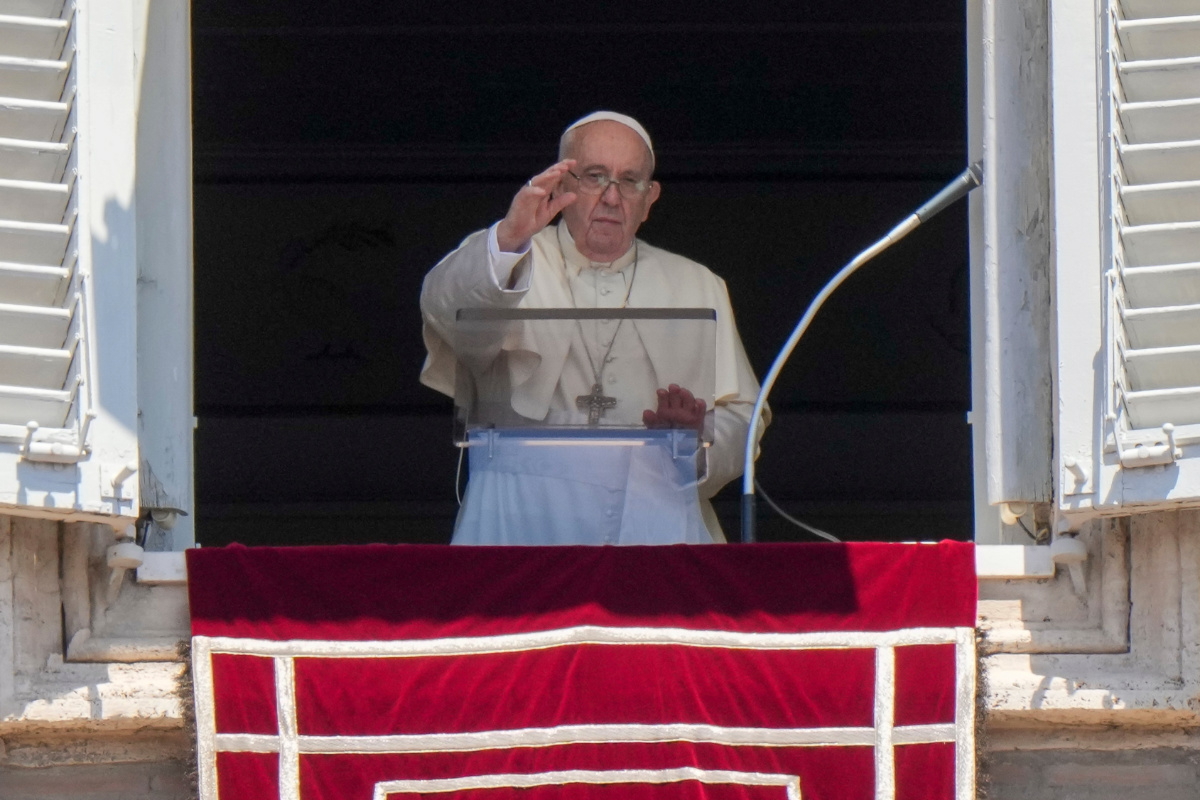
In an article published on Religion News Service, PHYLLIS ZAGANO, senior research associate-in-residence and adjunct professor of religion at Hofstra University in the US, looks at what Pope Francis’ effort to “take the pulse” of the Catholic Church has found…
Via RNS
More than a year ago, Pope Francis announced the Synod on Synodality, an initiative to take the pulse of the Catholic Church. The US Catholics have been mostly silent about this effort, but in several countries, including Australia, France, England and Wales and Germany, things are moving full steam ahead.
Two major problems have come up time and time again: clericalism and the place of women in the church.

Pope Francis delivers his blessing as he recites the Angelus noon prayer from the window of his studio overlooking St Peter’s Square, at the Vatican, on Sunday, 17th July. PICTURE: AP Photo/Andrew Medichini.
If you haven’t heard much about this effort, which completes its first phase this summer, you are not alone. In May, 2021, six months prior to the synod’s October, 2021, opening, the Vatican asked the world’s bishops to name synod coordinators in their dioceses, who were expected to organise a program of public meetings for Catholics, ex-Catholics and non-Catholics alike to talk about the church.
Some did. Some did not. Yet, somehow most US dioceses – 95 per cent, according to the US Conference of Catholic Bishops – wrote reports, though relatively few are published. Participating dioceses melded parish reports into diocesan reports, which were combined into regional reports. From the regional reports, as well as reports from some 110 independent Catholic organizations, the USCCB will create a 10-page report, due in Rome by mid-August.
“If you haven’t heard much about this effort, which completes its first phase this summer, you are not alone. In May 2021, six months prior to the synod’s October, 2021, opening, the Vatican asked the world’s bishops to name synod coordinators in their dioceses, who were expected to organise a program of public meetings for Catholics, ex-Catholics and non-Catholics alike to talk about the church.”
Some diocesan reports, such as those from Buffalo, Louisville, Salt Lake City and Trenton, point to clericalism and the lack of women in leadership as problematic. Louisville, Trenton and Salt Lake City noted calls for women deacons. The Buffalo report found “the abuse scandal [and] the lack of respect for women as manifested in an all-male clergy” caused declining church attendance and membership.
Even San Francisco, led by conservative Archbishop Salvatore J Cordileone, admitted to clericalism, and Washington, DC’s rosy report notes one core fact: People do not trust the bishops.
The synod is a worldwide event, and early reports from bishops’ conferences outside the US repeat the same story: Clericalism is a scourge on the church, and women are not respected or included in leadership.
Australia recently survived a rocky Plenary Council meeting, during which the country’s bishops voted down a statement “witnessing the equal dignity of women and men”, apparently because it included a request to restore women to the ordained diaconate. After nearly a quarter of council members protested, refusing to take their seats following a tea break, emergency meetings softened the statement to say the bishops would accept Rome’s decision on women deacons.
France reported deep dissatisfaction with the place of women in the church and the need to recognise their suffering and expectations.
England and Wales recognised that women were a “silenced, unrecognised majority…excluded from leadership and ministry.”
Germany went so far on these and other topics that it earned a published reminder from the Vatican: While they might discern, Rome would decide.
Once all the national reports get to Rome, the plan is to create a general document for another round of discussion next year, in preparation for the October, 2023, synod meeting of some 300 representatives in Rome.
Historically, synods are synods of bishops, but so far at least one woman, Xaverian Sister Nathalie Becquart, one of two undersecretaries (second-in-command) in the Rome synod office, will have a vote. The list of synod members, observers and experts should appear by the end of the year.
We rely on our readers to fund Sight's work - become a financial supporter today!
For more information, head to our Subscriber's page.
Whether anything will come of all this effort is anyone’s guess, but strong words – in several languages – are calling out supercilious clerics who, convinced they control access to heaven, are ruining the Church and chasing away members, especially women and girls. Overall, the people agree with Francis. These clerics do not. Whether clericalism can block calls for reform coming from the synod is uncertain.
How can this be?
For starters, the so-called “biological solution” touted by conservative Catholics is taking hold. As priest and bishop supporters of the Second Vatican Council and of Francis age out or die in place, they are replaced by a cadre of bishops ordained as priests during the reign of Pope John Paul II, who in turn appoint conservative pastors ordained during the reign of Pope Benedict XVI. Francis, as strong and alert as he is today, is not getting any younger.
Positive takes on the situation say the voice of the Holy Spirit is heard through the people, and God will steady the barque of Peter. But meanwhile, the Catholic Church as a force for good continues to lose influence inside and outside its walls, in large part because of how too many of its clerics treat women.
Phyllis Zagano is senior research associate-in-residence and adjunct professor of religion at Hofstra University, in Hempstead, New York. Her most recent book is Women: Icons of Christ.
This article contains an affiliate link.





